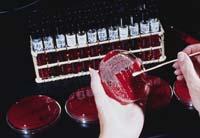Genome built from zero

The Craig Venter Institute has built a complete genome from scratch, according to an article published in the journal Science. They have formed the genome of the bacteria with the smallest known genome (Mycoplasma genitalium), from base to base. In addition to the bacteria's own bases, some brands have been added to know that DNA is artificial in areas that do not affect genome function.
The long strands of DNA are very fragile, so they created the sequence of the entire genome in parts, synthesizing 101 fragments -each of them from 5,000 to 7,000 bases-. Then they tied the pieces together until they got four strands of DNA, each one a quarter of the genome. They used the enzymes of the bacteria E. coli. To join these four pieces and get the whole genome a yeast was used.
Yes, they have synthesized it, but now they have to take another important step to prove that the work done is useful: introducing it into a bacterium without a genome and being able to live the bacteria with the new genome.





